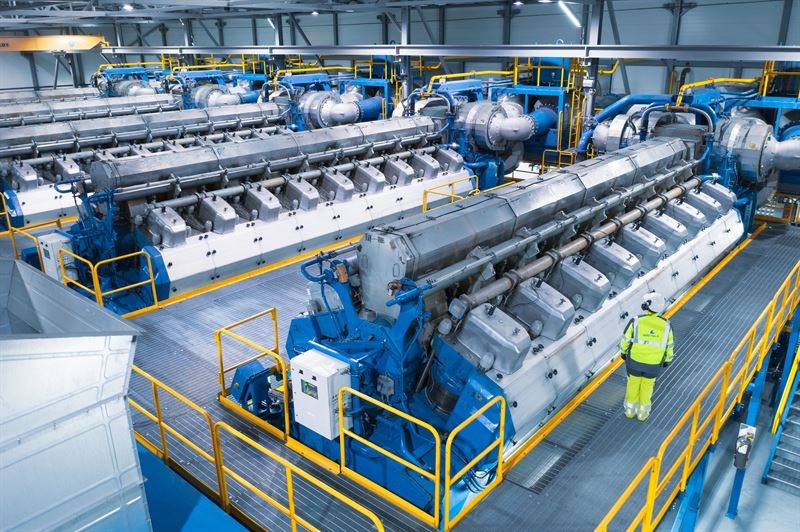

In Africa’s rapidly evolving energy landscape, conversations often center around the transition to renewables, and the promise of leapfrogging into a clean energy future. But as variable renewables surge onto the grid, a more grounded reality is becoming clear: without fast, flexible, and dispatchable power sources, the dream of renewable energy can quickly become a nightmare of instability. That’s where gas-engine power plants come in—not only as energy producers, but as grid balancers as well.
Grids and system flexibility: Africa’s emerging bottleneck
Across the continent, power systems are grappling with an uncomfortable trinity: aging and underbuilt transmission infrastructure, limited regional interconnection, and ambitious renewable energy targets. This combination is exposing a growing flexibility gap. Solar and wind, by nature, are variable and intermittent. They don’t ramp up on command. They don’t stabilize voltage or frequency on their own. Without complementary technologies to balance their fluctuations, they risk destabilizing the very systems they aim to power.
Filling the flexibility gap requires more than megawatts
Flexibility in a power system means having the right resources to quickly respond to changes in supply and demand. This includes:
- Fast-ramping generation - like Internal combustion engine power plants (ICE)
- Short- and long-duration energy storage
- Responsive demand-side technologies
- Updated grid codes and modern control systems
Yet most African grids were built for slow, steady thermal power—not high-penetration renewables or fast, automated balancing. In this context, ICE power plants, which offer far more than just megawatt-hours, represent a strategic asset for renewable grids. That’s why they are key players in solving Africa’s flexibility challenge.
There are multiple reasons as to why ICE power plants fit African grids so well:
- Adaptability: ICE can operate as effectively in baseload as in balancing mode - and can switch from one to the other without any modifications.
- Ultra-fast ramping: they are capable of reaching full power in under five minutes—ideal for smoothing out solar and wind fluctuations.
- Modularity: Built-in modular blocks, ICE technology allows phased investment and adaptation to local needs.
- High efficiency at low loads: ICE maintains strong performance even when operating at just 10% capacity—perfect for partial dispatch.
- Fuel flexibility: ICE is compatible with a wide range of fuels, from natural gas to future clean fuels.
- Low water use: that is a critical benefit in water-scarce regions!
- Ancillary service support: ICE plants can provide spinning reserve, voltage regulation, and synthetic inertia— these functions are vital in low-inertia systems.
In Africa’s patchy, under-resourced grids, these capabilities make flexible engine power plants not just useful—but essential.
Ancillary services: the unseen pillars of grid stability
Most grid users never hear the term “ancillary services,” yet they depend on them every time they switch on the light. These services—like frequency control, spinning reserve, and voltage regulation—keep the grid stable and operational. In high-renewables systems, the need for these services grows exponentially.
ICE plants are among the few technologies available today that can reliably and affordably provide these services at scale. Especially in grids lacking inertia or facing large demand spikes, these plants act as stabilizers—able to pick up slack and maintain system balance.
The missing piece: well-designed balancing markets
The value that ICE plants can deliver is clear. But properly monetizing that value is still a work in progress. Many African power systems still operate under vertically integrated, single-buyer models, where pricing is an issue, and ancillary services are either under-compensated or not priced at all.
To unlock more investment in flexible assets, transparent, functioning balancing markets are critical:
- They create price signals that reward flexibility and reliability.
- They reduce reliance on costly or inflexible baseload capacity, like coal or gas turbine power plants.
- They enable procurement of ancillary services on a competitive basis.
- They build investor confidence in the long-term value of dispatchable technologies.
While progress is being made—such as the early development of spot and balancing markets in countries like Kenya and South Africa—much more work is needed. These are not luxuries. They are pre-conditions for reliable, renewables-rich power systems.
Flexibility is not optional—it’s fundamental
Africa’s energy transition won’t succeed on solar and wind alone. It will require a flexible portfolio of technologies—batteries for speed, hydropower for depth, and ICE assets for reliable dispatch and grid-forming services.
To get there, governments and regulators must prioritize the creation of functioning ancillary service markets, underpinned by clear rules and credible tariffs. This will send the right signals to investors, de-risk flexible assets, and ensure that the grid remains as modern and resilient as the renewable technologies it aims to support.
ICE power plants, when properly valued, are not just stopgaps. They are the stabilizing backbone of Africa’s renewable energy future.
Did you like this? Subscribe to Insights updates!
Once every six weeks, you will get the top picks – the latest and the greatest pieces – from this Insights channel by email.
